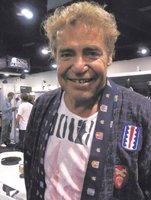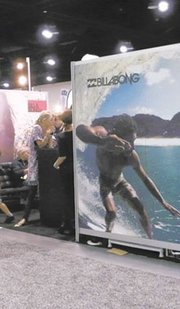More Work, Less Play at ASR
SAN DIEGO—Buyers were greeted with a very different vibe at the Action Sports Retailer Trade Expo at the San Diego Convention Center.
Once a marketing-heavy bastion of oversized booths, branding antics with roaming marching bands and scantily clad poster girls, ASR has steadily evolved over the past few seasons into more of a working marketplace.
Its latest incarnation is the most dramatic departure from the status quo yet.
For the two-day Fall 2010 show, held Feb. 3–4, ASR got a new look, put a greater focus on affordability with new turn-key booths and offered three distinct shows.
Skate brands, for the most part, moved out of ASR in favor of Crossroads, the regional skate-focused trade show that has partnered with ASR. It set up shop across the street in the Petco Park parking lot. Class@ASR, ASR’s new show catering to contemporary and crossover surf/skate brands, returned to San Diego for its second edition.
Andy Tompkins, vice president of Nielsen Sports Group, which produces ASR, said the three shows together roughly matched the square footage and 1,000 booths of the January 2009 edition.
ASR, with 700 booths, felt markedly smaller than in past years, due partly to some of the biggies sitting out the show. Hurley, Quiksilver, Roxy, Rip Curl, Matix and Reef did not participate.
Class@ASR, which was held one floor above ASR, rang in at approximately 200 booths, with Crossroads bringing up the rear with approximately 100 booths.
The segmentation may have contracted the ASR show floor, but it also expanded the show’s total offerings. Twenty-six percent more brands were represented on the show floor than the January 2009 show, Tomkins said.Working it
The turn-key booths that dominated the ASR show floor made for a much more uniform look and business-minded atmosphere. Priced to move, a 10-foot-by-10-foot turn-key booth cost $2,500. Opting for the new booth system saved brands nearly 50 percent of the cost of participating in ASR. “The idea was to make it more affordable for brands to participate in ASR,” Tompkins, said. “This show was only two days [long], and it is an efficient option.”
The shift from custom booths to ready-made booths earned mixed reactions from brands and buyers. “Some were taken aback by it,” Tompkins conceded, but he added that the ease of working a line in the functional booths compensated for the lack of the typical ASR flair.
Vince De La Pena of Element said he had some reservations about the new booth system but liked the layout. Greg Weisman, an attorney with Silver & Freedman who specializes in fashion and the action sports market, said the new face of the ASR show floor is a reflection of not only the action sports industry, but of trade shows in general. “The down economy has forced those in the trade show business to rethink their goals. ASR wants to be an effective platform for buying and selling. With this group it’s always a party, but that can’t be the priority right now, and I think most companies got that message loud and clear during the past year,” he said.
Tompkins said that while the majority of ASR’s exhibitors opted for the economic turn-key booths, he foresees some brands returning to their own customized booths in coming seasons.
On the Class@ASR show floor, a mix of brands brought freshness to the trade show and continued to attract a caliber of buyer not usually found at core surf/skate trade shows. Exhibitors ranged from fledgling brands to perennial favorites and included RVCA, Insight, Atwater, Comune, WeSC, Toddland, Ezekiel, Stuuml;ssy, LRG, Wellen, Ambsn, Alphanumeric and Fyasko.
In contrast with the chastened mood at ASR and Class@ASR, Crossroads held onto its gritty roots, offering skate ramps for skaters of all ages and exhibitors who were as likely to shave your head as to show you their product. Booths ranged from branded tents to converted moving trucks and upscale RVs.
While buyers reported liking the three distinct trade show floors, many said they would have preferred to see the three held side-by-side. “It was a huge waste of time to have to walk all the way to Crossroads and back for appointments,” said Ryan Marshall, president of the distributor VK Skate.
Fall back in time
In contrast to the more subdued environment, surf and skate brands showcased Fall 2010 product that buyers could get excited about.
For Fall, a ’70s throwback trend went hand in hand with the old-fashioned mustaches being sported by surfers and skaters these days.
Lightning Bolt showed boardshorts made of decidedly low-tech cotton-blend fabric, cut to mid-thigh and higher. Toddland, a Newport Beach, Calif.–based menswear maker, showed cut-off corduroy shorts just like dad used to wear. Farah showed cardigan sweaters and poly-blend trousers that overshoot dad and go straight for grandpa’s closet.
Even womenswear designers raided the vintage racks, showing belted cardigans in Native American prints from the ’70s, prim blouses from the ’50s, and glam-rock denim jackets and printed skinny jeans from the ’80s.
While men’s surf/skate fashions have left the ’80s, women’s designers kept the trend going for Fall.
Ezekiel showed a cropped, batwing denim jacket straight out of a White Snake video. O’Neill displayed pale super-skinny jeans printed with lace, a bleached denim jacket with studded shoulders and boxy crop tops in throwback prints. Insight had over-dyed animal-print skinny jeans, a studded denim vest and an oversized, paint-splattered sleeveless boyfriend shirt. 3&A showed acid-wash skinny jeans and dipped a toe into ’90s-era grunge with a plaid jumper dress.
The greaser look peppered Fall collections, with many brands offering their take on fitted denim jackets and super-crisp, sometimes wax-coated, jeans for men.
Comune, whose sales force wore the brand’s take on the trend and looked like characters from “The Outsiders,” showed an inky, tailored denim jacket with motorcycle-jacket styling. Aknowledge went so far as to have jeans with distressing and paint splatters, making the wearer look like he’s been working on his hotrod or hog all day.
Workwear also proved to be a big trend for Fall, dovetailing nicely with vintage military-inspired fashions, another prominent Fall trend. Chambray button-up shirts were dressed up with contrast-stitching, miss-matched buttons, epaulets, hoods and asymmetrical pocketing. Military jackets were updated with fleece fabrications, built-in hoods, detachable sleeves, loads of zippers and quirky pockets.
The next ASR, which will include Crossroads and Class@ASR, is set for Aug. 13–15 in San Diego.
Click here for the “Boardwalk to Catwalk” ASR fashion show.


























